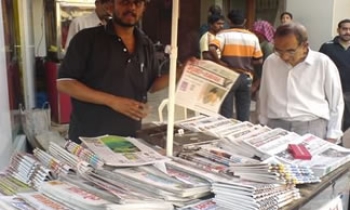NEW YORK: Newspaper executives have been making strides in reducing churn, holding on to paid circulation -- even though it's heavily discounted -- and slinging out less valuable circ, like hotel copies. And while those efforts are laudable, there's another anchor dragging down print revenue: single-copy sales.
It's a long way indeed from the days when the popular image of newspapers was based on youthful street hawkers, crusty old newsstand managers, and omnipresent news racks.
John Murray, the Newspaper Association of America's vice president of circulation, says that daily single-copy sales dipped roughly 5% for the six-month period ending September 2006. Some markets, he contends, have experienced much larger drops on Sunday. Compare that to the overall decline in circulation for the same period, where daily and Sunday fell "only" 2.8% and 3.4% respectively.
"Single copy has been more of an issue than home delivery," says Prudential Equity Research analyst Steven Barlow, citing the former category as the most likely culprit for overall sinking circ numbers.
Home-delivered subscriptions now make up the bulk of circulation at newspapers -- somewhere in the ballpark of 76%, depending on the market. Though single copy represents a much slimmer piece of the pie, it's extremely important, especially in terms of revenue, and the most vulnerable part of circulation: "It's a lot more at risk than home delivery, and the numbers bear that out," says Paul Ginocchio, an analyst with Deutsche Bank Securities.
Those gaugeing the atmosphere look to this category as the true barometer of the industry. Barlow wrote in the latest take-down on "quality circulation" in the firm's semi-annual report: "Full-paid single copy provides a better indication of the printed newspaper as a media choice, as it represents the most basic example of a consumer actively seeking out the newspaper."
With that in mind, the NAA released in late December a comprehensive study of single-copy sales. The report is a follow-up to the original research the organization conducted in 2001 in five scattered markets: Dayton, Ohio; Jacksonville, Fla.; Hartford, Conn.; Oklahoma City, and Reno, Nev. This time around, the NAA added two additional markets to the survey: Frederick, Md., and Sacramento, Calif.
MORI Research conducted the study on behalf of the NAA from November 2005 through February 2006; surveys were inserted into newspapers distributed at single-copy sales locations. Those who returned the form received a follow-up letter with additional questions. A total of 5,152 people responded.
The 2006 research revealed several subtle trends. Buyer behavior has become more erratic when it comes to purchasing papers at the newsstand (or local convenience store or supermarket). This means front-page design and hard-driving marketing tactics are even more necessary to ramp up sales, the study suggests.
And of course, pricing remains as sensitive as ever. According to the report, 80% of those surveyed found the daily paper to be a "good value" at 50 cents. But when the cost creeps up to 75 cents? Forget it, they said. Only 16% would shell out an additional quarter, or so they claimed.
The report also teases out a few important demographic stats. Young people, it turns out, do read the paper, and they tend to purchase single copies. Thirty-one percent of all daily single-copy buyers are between the ages of 18 and 34. That number is shrinking, however, "indicating a growing weakness among young adults," according to the report. In 2001, 36% of single-copy buyers fell in the same age bracket.
For all the jabber surrounding "local, local, local" (or even hyperlocal) content, for the first time in this report, metro news sailed by national news in terms of importance. In this latest study, 65% said the metro section was their favorite, versus 60% who said the "A" section, a reversal of previous findings.
There's no way around it: The Internet has had the biggest impact on single-copy sales among young and old alike. Why plunk down anything, even occasionally, when you can get it for free? According to the report, a "significant portion of online visitors" (15%) have put the brakes on their single-copy purchases. More discouraging news is that 4% cancelled their home subscriptions. But people are still reading the paper, somewhere: Fifty-eight percent said the newspaper Web site has replaced the print edition rather than complement it, while 43% read both. (For more on the survey's findings, see p. 64.)
An opportunity in disguise?
So single-copy sales might be sinking, but all is not lost. One of the takeaways from the report, says the NAA's Murray, is that newspapers "have to be everywhere," since lifestyle changes account for much of the shift away from single-copy purchases.
Murray sees the glass as half full: "When you look at the statistics, and you see that half or more in some markets of single-copy purchasers buy only three or four times a week, that is encouraging. That means there is opportunity for growth. That defines what circulation marketing is about. It's not about converting non-readers into readers, but increasing frequency."
While it's heartening that readers flock to newspaper Web sites, it's still imperative that publishers hang on to single-copy circ even at modest levels.
"If you are flat on single-copy sales, I think you are a success," says Hugh McGarry, chair of the NAA's single-copy committee and senior vice president of circulation at the Milwaukee Journal Sentinel. "The days of throwing a box out on the street and selling papers out of that box are gone. We have to adjust to retailers and use our space wisely and promote our product."
The coin-operated news boxes and scrappy paperboys are quaint relics of the past, soon destined for an exhibit at the Newseum. Convenience marts, supermarkets (especially value-based retailers) and less traditional places -- think, smoothie huts -- are taking on increased importance in growing single-copy sales.
It doesn't take much to boost that circulation category, but it requires much more than simply dropping off a bundle of copies. A combination of marketing, placement, pricing, and innovative front-page design are necessary if a publisher wants to coax money out of people's pockets. Several newspapers, from large metros to small dailies, have improved their numbers just by paying attention to such details as where people shop.
In-store incentives pay off
The Sacramento Bee is one paper that wanted to boost its single-copy sales. Even though Sacramento is an expanding market -- and owner McClatchy was once known for rarely suffering circ reversals -- the Bee has been steadily losing daily single-copy circulation. Since 2004, daily single copy fell a whopping 13.1% (based on a comparison of the March 2004 and September 2006 publisher's statements).
That loss in volume didn't deter Dan Schaub, the Bee's senior vice president of circulation, who only saw the upside. "It started with the premise that we could actually grow circulation," he says. As an added measure and daily reminder, his team wore bracelets with the inscription "We believe in the business."
"We knew we were in a growth market," echoes Kelly Swift, director of circulation, retail sales, and marketing at the Bee. She cites the true measure of an exploding market: "We were seeing Starbucks pop up everywhere."
After conducting research and armed with market stats, Schaub and his team realized they were not making the paper available in enough places. He had a consumer's eye-view himself, when he moved to a growing community and couldn't find the Bee. That prompted him to add more coin-operated racks to the market. Even though, he admits, many in the industry think it's a hassle to grow rack numbers, the Bee increased its boxes from about 1,250 to 1,757 under Schaub's directive.
"Consumer behavior has changed," Schaub explains. "They will not go out of their way to find your product. … If they go to Starbucks, you have to be inside Starbucks and be in their pattern. They won't turn the corner to find you."
Furthermore, the circulation department was caught off guard in the rise of drug store chains like Rite Aid. Sure, the Bee was available in those retail outlets, but they didn't keep up with the pace. "We were in about 13 or 14 Rite Aids," recalls Swift. "We found out there were 38 Rite Aids in the market."
In addition to upping racks and distribution in retail outlets, the Bee made sure to hit the streets in an effort to get to know managers and store clerks -- the people who decide the placement and sale of the product, much like Jimmy Newsboy of old.
To get the copies flowing, the circulation team approached sales clerks with a "mystery shopper" incentive program. Sales clerks who suggested to any customer that they buy the Bee, would receive money on the spot -- $10 to $20 -- if a team member "caught" them doing it, during a surprise visit. Using the power of peer pressure, the Bee distributed a newsletter every week to the participating stores listing who won the cash. Those clerks who failed to mention the Bee during the covert visits were also listed. "We saw a big difference with that," Swift says.
The mystery-shopper contest was combined with price pulsing (a reduction in the price of the paper). Initially, sales grew 17% during the promotion. Even after the price went back up and the incentive program ended, single-copy sales grew 8%.
The Bee also reached outside its scope and started a dry run with the popular and ever-expanding Jamba Juice chain. After working closely with the juice company's corporate headquarters to develop racks and displays, the Bee has been selling copies in six stores over a three-month test period -- on average about 20 daily and 29 Sunday copies total. They expect sales to jump 50% when warmer weather sets in. "These are people who wouldn't have bought our paper," Schaub says.
Breaking down the 'Wal'
One of the key points to selling more newspapers sounds so simple it's silly: Get in front of more people. Every circulation executive, then, would want to get involved with Wal-Mart.
Never mind that the big-box retailer is aggressively anti-newspaper. But that didn't stop David Keyes, editor and publisher of the tiny 6,000-circ Bonner County Daily Bee in Standpoint, Idaho.
The big cheeses in Bentonville, Ark., decided the Standpoint Wal-Mart would become a super center. At the old Wal-Mart, the Daily Bee had a dinky rack outside the store but decided to aim bigger. "We thought of course, this is a huge, huge building," says Keyes. "With so many people coming in there, it's a circulator's dream."
At first, Wal-Mart would have none of the Daily Bee. But Keyes noticed the store requested five copies of the paper, every Wednesday. Wal-Mart managers were taking out the inserts so they could beat the prices at other area stores. "I personally delivered those for the first couple of months to get a hand on their culture," Keyes says.
It took six months before Wal-Mart would consider letting Keyes even broach the topic of selling papers in the store.
At the same time, Keyes recalls that Wal-Mart was trying to get every little piece of its own local publicity/promotion into the Daily Bee. "They were pretty ridiculous," he says, citing one release trumpeting Wal-Mart's donation of old dog food to a shelter. "There must be a playbook somewhere that said, 'Let's get our name in the paper.'"
Of course, Wal-Mart was miffed when handouts got spiked and felt that it was not receiving adequate coverage. Keyes saw another opportunity and met with the managers to hear their concerns. They decided that the paper would only consider running stories in cases where Wal-Mart donated $1,000 or more to the community.
Now the Daily Bee has 22 displays within the super center -- with prime racks topping soda coolers at the check-outs -- and in-store exclusivity for local newspaper sales. Sales increased 200% when the displays first went up in 2002 and single-copy circulation is still growing, up 20% a year. Keyes had to order racks with deeper wells to keep up with the demand. "It's a problem we would all like to have," he quips.
While that relationship has not translated into advertising from Wal-Mart, the retailer is one of the paper's biggest boosters, taking on several sponsorships including a golf tournament to support Newspapers in Education. "We would probably make more money if [Wal-Mart] were running a full-page, run-of-press ad every Tuesday, but that's not they way they operate," Keyes says. "The challenge we have in this industry is to recognize that is [Wal-Mart's] culture and figure out how to maximize it."
Any gains are good gains
The Detroit Newspaper Partnership, which jointly operates The Detroit News and Detroit Free Press, was handed a break on a platter last year with the Motor City hosting the Super Bowl, the underdog Tigers making it to the World Series, and the Red Wings and Pistons doing well in hockey and basketball. Both newspapers made year-over-year gains in single-copy sales thanks in part to a sports-crazy town.
But Jeff Gibson, single-copy sales manager at the Detroit Newspaper Partnership, says it takes more than a good sports year to spike circulation. The papers have new presses with more color capability and Gibson has been energetically running promotions, 16 over 18 months. "I would really love to sit here and say, 'We did this and sold more newspapers.' To be honest, it's a combination of all of the above," he adds.
Some of those promotions were duds, even ones that involved a free gas giveaway. The papers ran four of those promos, and only some were successful. Unless sales clerks are behind the giveaway, it can easily flop, Gibson notes. The ones that went well were the promotions that emphasized suggestive selling and incentives.
Sales clerks aren't the only ones that need to be involved. NAA chair McGarry points out that the circulation departments are feeling the dramatic cutbacks sweeping the industry. "A lot of papers have cut single-copy management in the field," he says, referring to those whose job it is to go out and check in on the displays and rally the salespeople.
Since their numbers are dwindling, publishers increasingly are relying on drivers distributing the papers to spruce up point-of-purchase material and make sure it's conveying the correct message.
Gibson came up with a strategy to simplify the insertion of rack cards by using a plastic adhesive strip, from the Keenan Group. The partnership's creative team christened it the "Gibson." It's only 6 inches and you can put multiple cards in one rack, he says. "It has allowed for drivers to put up [cards] in an instant."
While the papers increased single-copy circulation by about 1.5%, Gibson knows he's up against some brutal comparisons. "Right now it's a little tougher," he admits. "We rode this huge wave into November. All of a sudden the Tigers lost, and people don't get excited about the Pistons and the Red Wings until the playoffs. We hope to be able to improve on last year," he adds, aware of the uphill trudge facing all circ managers. "Our goal is to be flat -- which will be a great success story."
Jennifer Saba (jsaba@editorandpublisher.com) is associate editor at E&P.









